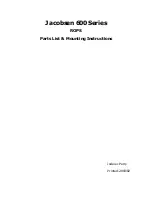
19
WARNING!
When filling the machine, never pass under a load which is suspended from a loader
or otherwise lifted, or under the lifting structure.
When using loose fertilizer and/or seeds, we recommend the use of a high-tipping trailer or fill-screw
. When
using a tipping trailer, the tipping point must be selected with care in order to prevent the carriage
from overturning
. As the JC support wheels and harrow are located at the rear of the machine, certain filling
carriages may not have sufficient reach. The containers can then be filled from the side of the machine as
required.
8. Emptying containers
Emptying the fertilizer container
The fertilizer container is emptied through the coulters or by using the test seed troughs.
If the seed container is not fully emptied, care must be exercised to prevent seeds from falling into the
fertilizer. For this reason, remove the seed feeding cassette (see Figs. 22 and 23) when the seed
feeding does not rotate by means of the ground-wheel or by rotating the fertilizer shaft.
Set the load cover under the machine.
Set the fertilizer feed to the maximum feed amount.
Lift the fertilizer side feeding equipment lever for the bottom flaps over the scale (Figs. 26 and 28).
The container will then empty almost completely.
Guide the remaining fertilizer, e.g. with a brush, to the feed chambers. Rotate the feeding device with
the ground-wheel a number of times, see Fig. 29, until the chambers are empty. Then, swing the
bottom flaps back and forth fast with the adjustment lever until the last fertilizer grains fall out through
the coulters.
Pull the cover out from underneath, and install the seed side feeding equipment power transmission
cassette back in the original manner.
Emptying the seed container
The feed container can be emptied through the coulters or using the test seeding troughs.
Empty through the coulters, i.e. the load cover is spread underneath the coulters.
Adjust the feeder to the maximum feed amount during the emptying process.
The seed container is emptied by lowering the bottom flap crank fully over the scale (Figs. 20 and 24).
Guide the remaining seeds into the feed chambers.
Rotate the feed equipment a few times so that the seeds remaining on the feed rollers flow downward.
Note that when rotating the feeder, some of the fertilizer may flow on top of the load cover unless the
fertilizer container has been emptied beforehand, or unless the fertilizer feed shaft has been rendered
inoperable with a ring pin (Fig. 27).
Swing the bottom flaps fast with the crank a few times so that no seeds are left on top of the flaps.
The containers can be emptied using the test seeding troughs if only small amounts of seed and
fertilizer remain in the containers. Use of the test seeding troughs is described in Section 12.
The method for emptying is essentially as described above. If large amounts of seed remain in the containers,
the bottom flap crank must be closed when emptying the troughs.
WARNING!
If compressed air is used to clean the containers, remember to use adequate protection
to prevent pollen dust, seed treatment, etc. from penetrating the respiratory system and
eyes!
















































